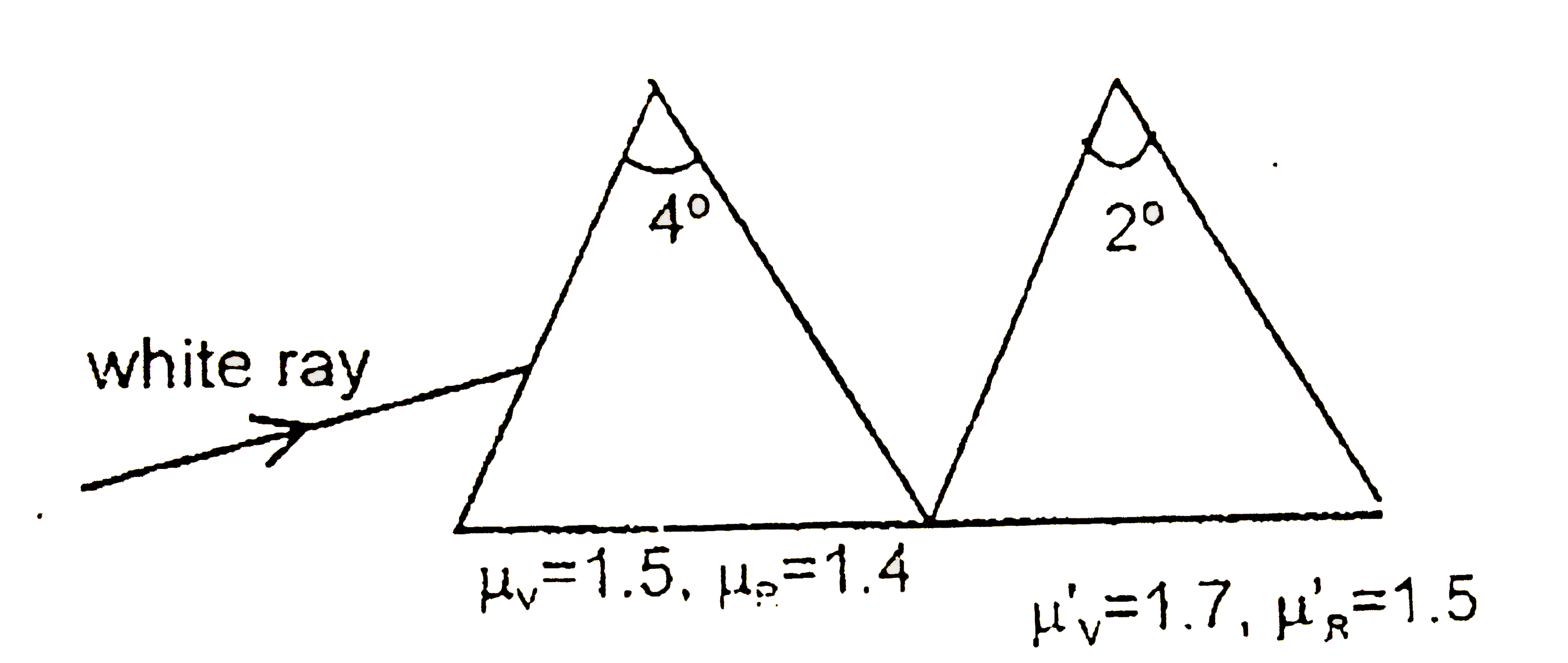Two prisms A and B are in contact with each other have angular dispersions of and respectively. The dispersive power of A is 0.002. If the combination produces dispersion without deviation, the dispersive power of B is
0.001
0.004
0.002
0.006
The correct Answer is:B
To find the dispersive power of prism B, we can follow these steps:
Step 1: Understand the given information
We have two prisms, A and B:
- Angular dispersion of prism A, θA=2∘
- Angular dispersion of prism B, θB=4∘
- Dispersive power of prism A, ωA=0.002
We need to find the dispersive power of prism B, ωB, under the condition that the combination produces dispersion without deviation.
Step 2: Use the condition for dispersion without deviation
The condition for dispersion without deviation for two prisms in contact is given by:
θAωA+θBωB=0
This implies:
θAωA=−θBωB
Step 3: Substitute the known values
Substituting the known values into the equation:
20.002=4ωB
Step 4: Solve for ωB
Cross-multiplying gives:
2⋅ωB=4⋅0.002
2⋅ωB=0.008
Now, divide both sides by 2:
ωB=0.0082=0.004
Step 5: Conclusion
The dispersive power of prism B is:
ωB=0.004
Final Answer
The dispersive power of prism B is 0.004.
---
We have two prisms, A and B:
- Angular dispersion of prism A, θA=2∘
- Angular dispersion of prism B, θB=4∘
- Dispersive power of prism A, ωA=0.002
The condition for dispersion without deviation for two prisms in contact is given by:
θAωA+θBωB=0
This implies:
θAωA=−θBωB
Substituting the known values into the equation:
20.002=4ωB
Cross-multiplying gives:
2⋅ωB=4⋅0.002
2⋅ωB=0.008
Now, divide both sides by 2:
ωB=0.0082=0.004
The dispersive power of prism B is:
ωB=0.004
The dispersive power of prism B is 0.004.
Topper's Solved these Questions
- GEOMETRICAL OPTICSBOOK - AAKASH SERIESCHAPTER - GEOMETRICAL OPTICSEXERCISE - LECTURE SHEET (EXERCISE II LEVEL -II (ADVANCED) MORE THAN ONE CORRECT TYPE QUESTIONS)
7 Videos
- GEOMETRICAL OPTICSBOOK - AAKASH SERIESCHAPTER - GEOMETRICAL OPTICSEXERCISE - LECTURE SHEET (EXERCISE II LEVEL -II (ADVANCED) LINKED COMPREHENSION TYPE QUESTIONS)
9 Videos
- GEOMETRICAL OPTICSBOOK - AAKASH SERIESCHAPTER - GEOMETRICAL OPTICSEXERCISE - LECTURE SHEET (EXERCISE II LEVEL -I (MAIN) STRAIGHT OBJECTIVE TYPE QUESTIONS)
17 Videos
- ELEMENTS OF VECTORSBOOK - AAKASH SERIESCHAPTER - ELEMENTS OF VECTORSEXERCISE - QUESTIONS FOR DESCRIPTIVE ANSWERS
10 Videos
- LAWS OF MOTIONBOOK - AAKASH SERIESCHAPTER - LAWS OF MOTIONEXERCISE - PRACTICE EXERCISE
106 Videos
Similar Questions
Knowledge Check
A thin prism of angle 15∘ made of glass of refractive index μ1=1.5 is combined with another prism of glass of refractive index μ2=1.75. The combination of the prism produces dispersion without deviation. The angle of the second prism should be
A5∘B7∘C10∘D12∘
If a glass prism in dipped in water its dispersive power
View SolutionThe deviation caused for red, yellow and violet colours for crown glass prism are 2.84∘,3.28∘ and 3.72∘ respectively. The dispersive power of prism material is:
View SolutionThe dispersive power (w) of the material of a prism is (where symbols have their usual meanings)
View SolutionA thin prism having refracting angle 10∘ is made of glass of refracting index 1.42. This prism is combined with another thin prism of glass of refractive index 1.7. This combination produces dispersion without deviation. The refracting angle of second prism should be :
View SolutionThe refractive indices of a material for red, violet and yellow colour lights are 1.52, 1.62 and 1.59 respectively. Calculate the dispersive power of the material. If the mean deviation is 40∘ what will be the angular dispersion produced by a prism of this material ?
View SolutionTwo small angled prisms A and B deviate the blue rays by 6∘ and 8∘ and the red rays by 4∘ and 6∘ respectively. Which prism has a greater dispersive power ?
View SolutionIf two prisms are combined , as shown in figure, find the total angular dispersion and angle of deviation suffered by a white ray of light incident on the combination.

View Solution
